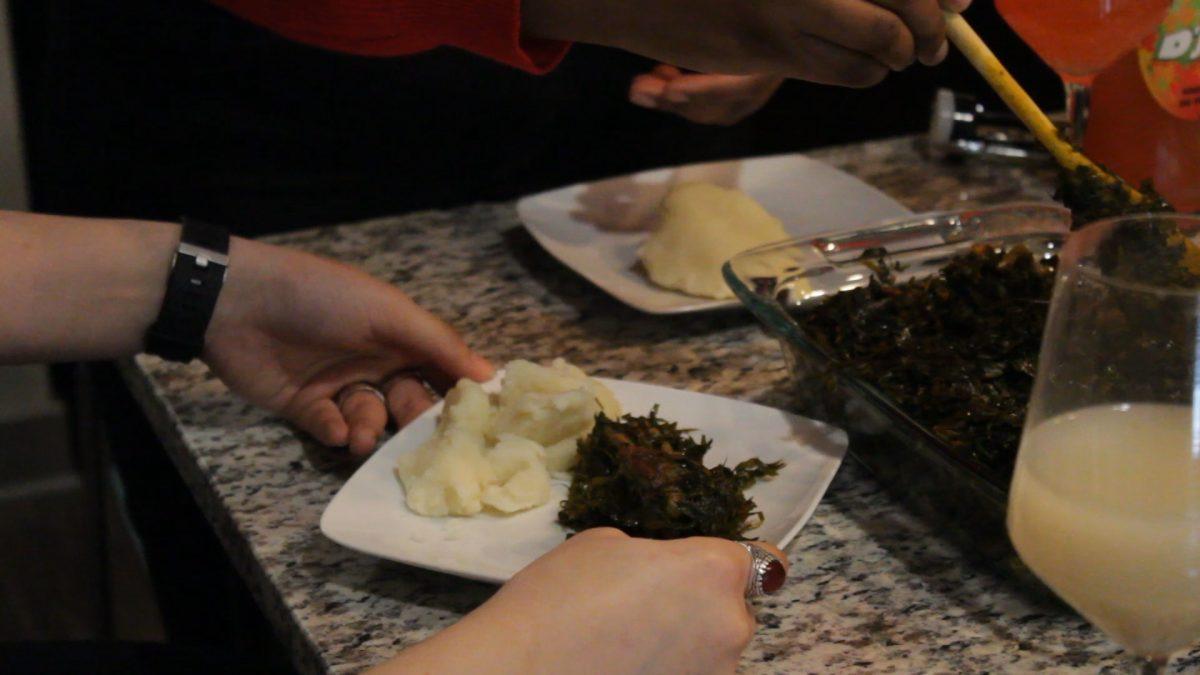
Photo by Ryan Magee | Mercury Staff.

Although African
cuisine in general has been significantly influenced by centuries of
colonialism, it still remains fairly unique compared to other cuisines in
neighboring continents and countries. This episode, I had the opportunity to
make a traditional Cameroonian dish, eru, with fellow Mercury staffer Cindy
Folefack.
Contrary to what I believed, eru is
actually pronounced “err-oh,” with a guttural “r.” Eru is a Cameroonian dish
made from okazi leaves, spinach and different types of meat such as beef,
turkey or fish. The okazi leaves have a surprisingly large amount of protein and make for a sizeable meal when
combined with the different meats. Eru is traditionally eaten with fufu, which
is a staple side food made from ground cassava or plantain. Mixed with water
and vigorously pounded in a pot, fufu is fluffy and doughy.
Making the eru was simple enough and
wasn’t very different from making a stew or soup. Folefack had me chopping beef
chunks to be simmered in a pot along with some chicken bouillon cubes, dried
fish and crayfish. The dried fish still had the bones in them and were fairly
sharp so Folefack instructed me to hold the bag of dried fish from the top so
my fingers wouldn’t be poked by the bones in the bag. Much to my despair, she
added a hefty amount of the dried fish with the bones still intact into the
pot.
She soaked the eru leaves in a large
bucket of water and left it to sit for about 15 minutes. After the meat was
fairly soaked and cooked through, she added spinach and eru leaves. She also
garnished the stew with some oil from large bottle filled with a thick bright
orange substance, which turned out to be palm oil. I noticed throughout the
cooking process that she added little to no spices other than palm oil and the
bouillon cube, which was added for taste.
Fufu was even
simpler to make — we added a pink-tinted flour to a boiling pot of water and
stirred vigorously to make the fluffy dough. We then wrapped it in plastic to
maintain its shape and left it to cool.
When we sat down to eat the eru,
Folefack gave me some palm wine, which is a drink made from the sap of palm
trees such as coconut and date palm trees. It looked very milky and green and
tasted faintly of kombucha drink and ginger ale, but without the carbonation.
She told me repeatedly that she hated the drink, but I ended up finishing my
glass gleefully as she looked on in disgust.
Trying eru was
something entirely different. Folefack instructed me to take a bit of the fufu
and eru together into one morsel in my fingertips. This was something I was
used to because we use the same method to eat Pakistani dishes, except we use
thick bread called roti or naan. During the first bite, I felt something hard
and sharp in my mouth and was terrified that it was a fish bone. Thankfully, it
turned out to be the okazi leaves, which were hardy and thick. The okazi leaves
and spinach went wonderfully with the beef and other meats in the dish. The
flavor was rich, and I was surprised to note that neither the fish nor the beef
overpowered the other. The fufu tasted like a thicker version of mashed
potatoes, but the combination of soft fufu and hard and chewy eru worked well
together.
It is interesting how this
Cameroonian dish doesn’t include any sort of spices beyond basic salt, pepper
and flavors from different meats. Folefack told me that African dishes usually
contained so much meat that sometimes she would crave vegetarian dishes. The
stew smelled strong but fresh, and I could sense that the taste would mostly
consist of the flavors of the beef, spinach and Okazi leaves themselves. Coming
from a culture where we normally marinate everything we eat in masala, spice
powders and oils, it was a strange concept for me, but it wasn’t an unpleasant
experience. On the contrary, I found it refreshing to be able to experience the
raw flavors of the ingredients of a dish, and eru was definitely a worthwhile
dish to try.